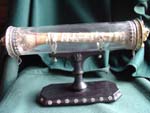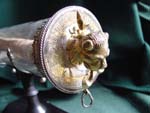Rehabilitation
of the Interest in Medieval Art and Spirituality
Catholic Emancipation, and the Impact of Museums
 A
Stonyhurst Reliquary of Thomas
of Hereford illustrates both the liberation of Catholic tradition
and the rehabilitation of medieval art styles. The shrine of Thomas
at Hereford Cathedral,
like that of Thomas
of Canterbury was a popular pilgrimage site. Unlike the swift
destruction of the Canterbury shrine in
A
Stonyhurst Reliquary of Thomas
of Hereford illustrates both the liberation of Catholic tradition
and the rehabilitation of medieval art styles. The shrine of Thomas
at Hereford Cathedral,
like that of Thomas
of Canterbury was a popular pilgrimage site. Unlike the swift
destruction of the Canterbury shrine in  1538,
the Hereford relics were only dispersed in 1665. One bone was kept
at the Jesuit mission in Holywell, North Whales. In 1835 it was given
to Stonyhurst and encased in new Gothic Revival reliquary made by
John Hardman of Birmingham. Hardman, a Catholic, was the preferred
firm of Augustus
N. W. Pugin, also a Catholic, and premier Gothic Revival architect
of England. Stonyhurst preserves plans for a more elaborate reliquary
shrine that was never executed.
1538,
the Hereford relics were only dispersed in 1665. One bone was kept
at the Jesuit mission in Holywell, North Whales. In 1835 it was given
to Stonyhurst and encased in new Gothic Revival reliquary made by
John Hardman of Birmingham. Hardman, a Catholic, was the preferred
firm of Augustus
N. W. Pugin, also a Catholic, and premier Gothic Revival architect
of England. Stonyhurst preserves plans for a more elaborate reliquary
shrine that was never executed.
 Stained
glass from the Continent was collected by Catholics early in the 19th
century. The Jerninghams were an important Norfolk family whose country
seat was Costessy Hall just south of Norwich. They were particularly important
in Anglo-Catholic affairs between the Catholic Relief Act of 1778 that
removed restrictions on leasing and inheriting land to the Act of Emancipation
of 1829. Around 1800 Sir William built a new family chapel for his own
use and to serve as the parish church for a substantial portion of the
population of the village of Costessy. He imported medieval glass to set
in its windows, works of art that brought a strong identification of Catholicism.
Costessy Hall was dismantled in 1918 and sold in its entirely to Grosvesnor
Thomas a dealer who furnished numerous panels to American Collectors.
The Jerningham panels are represented in numerous collections in Europe
and America, including the Worcester Art Museum's Donor
Portrait of Prior Peter Blommeveen, 1510-30 and the French Annunciation
1525-35, on the right, acquired by Portsmouth Abbey, Rhode Island.
Stained
glass from the Continent was collected by Catholics early in the 19th
century. The Jerninghams were an important Norfolk family whose country
seat was Costessy Hall just south of Norwich. They were particularly important
in Anglo-Catholic affairs between the Catholic Relief Act of 1778 that
removed restrictions on leasing and inheriting land to the Act of Emancipation
of 1829. Around 1800 Sir William built a new family chapel for his own
use and to serve as the parish church for a substantial portion of the
population of the village of Costessy. He imported medieval glass to set
in its windows, works of art that brought a strong identification of Catholicism.
Costessy Hall was dismantled in 1918 and sold in its entirely to Grosvesnor
Thomas a dealer who furnished numerous panels to American Collectors.
The Jerningham panels are represented in numerous collections in Europe
and America, including the Worcester Art Museum's Donor
Portrait of Prior Peter Blommeveen, 1510-30 and the French Annunciation
1525-35, on the right, acquired by Portsmouth Abbey, Rhode Island.
English museums,
such as the South Kensington Museum, later named the Victoria
and Albert Museum, collected medieval art. From its inception, the
London Museum defined its purpose as "secular" - to acquire
examples of ancient craft and design that would serve as inspiration for
contemporary artisans. In 1855, for example, stained glass from Rouen
showing three incidents in the life of St. Peter (2207 to 2209-1855),
including his martyrdom was acquired. The disputed past of England became
"our" past with little reference to fractious dispute or the
role of the government in the destruction and suppression of religious
subject matter. With the Gothic Revival the medieval past achieved a new
national aura.
